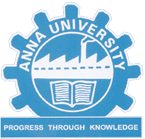 ANNA UNIVERSITY CHENNAI:: CHENNAI 600 025
ANNA UNIVERSITY CHENNAI:: CHENNAI 600 025
CURRICULUM 2004
B.TECH. INFORMATION TECHNOLOGY
IT1009 WEB SERVICES 3 0 0 100
AIM
To understand the concept of XML and to implement Web services using XML based standards.
OBJECTIVES
• To understand the advantages of using XML technology family
• To analyze the problems associated with tightly coupled distributed software architecture
• To learn the Web services building block
• To implement e-business solutions using XML based web services
UNIT I XML TECHNOLOGY FAMILY 9
XML – benefits – Advantages of XML over HTML, EDI, Databases – XML based standards – Structuring with schemas - DTD – XML Schemas – XML processing – DOM – SAX – presentation technologies – XSL – XFORMS – XHTML – Transformation – XSLT – XLINK – XPATH – XQuery
UNIT II ARCHITECTING WEB SERVICES 9
Business motivations for web services – B2B – B2C – Technical motivations – limitations of CORBA and DCOM – Service-oriented Architecture (SOA) – Architecting web services – Implementation view – web services technology stack – logical view – composition of web services – deployment view – from application server to peer to peer – process view – life in the runtime
UNIT III WEB SERVICES BUILDING BLOCKS 9
Transport protocols for web services – messaging with web services - protocols - SOAP - describing web services – WSDL – Anatomy of WSDL – manipulating WSDL – web service policy – Discovering web services – UDDI – Anatomy of UDDI – Web service inspection – Ad-Hoc Discovery - Securing web services
UNIT IV IMPLEMENTING XML IN E-BUSINESS 9
B2B – B2C Applications – Different types of B2B interaction – Components of e-business XML systems – ebXML – RosettaNet - Applied XML in vertical industry – web services for mobile devices.
UNIT V XML CONTENT MANAGEMENT AND SECURITY 9
Semantic Web – Role of Meta data in web content - Resource Description Framework – RDF schema – Architecture of semantic web – content management workflow – XLANG – WSFL – Securing web services
TOTAL : 45
TEXT BOOK
1. Ron Schmelzer et al. “ XML and Web Services”, Pearson Education, 2002.
REFERENCES
1. Keith Ballinger, “. NET Web Services Architecture and Implementation”, Pearson Education, 2003.
2. David Chappell, “Understanding .NET A Tutorial and Analysis”, Addison Wesley, 2002.
3. Kennard Scibner and Mark C.Stiver, “ Understanding SOAP”, SAMS publishing.
4. Alexander Nakhimovsky and Tom Myers, “XML Programming: Web Applications and Web Services with JSP and ASP”, Apress, 2002.

0 comments:
Post a Comment